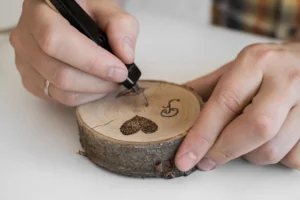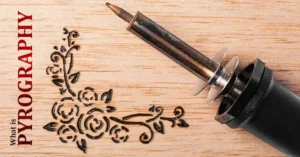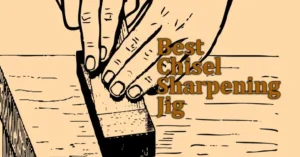Gardening axe used for chopping and cutting various materials in gardens and outdoor settings. Also known as Hatchets, Hand Axe, or Grab Axe. It is very useful for gardening.
The history of the axe can be traced back to ancient civilizations. They are used in wood cutting, building, and even as weapons.
Over time, the design of the axe has evolved to become more specialized and suited to specific tasks.
Today, gardening axes are generally smaller and lighter than traditional axes. They come in different shapes, sizes, and weights.
Table of Contents
What is a gardening axe?
A gardening axe is a tool used for chopping and cutting wood, roots, and branches in a garden or other outdoor setting. They typically have a smaller head and shorter handle, which makes them more suitable for smaller jobs and more precise work.
Different types of gardening axe
There are several different types of gardening axes, each designed for specific tasks:
- Felling axe: This axe is designed for cutting down trees and large branches. It has a long handle and a large, heavy head for maximum power.
- Splitting axe: Used for splitting logs and other large pieces of wood. It has a long handle and a heavy head with a sharp edge on one side and a flat surface on the other.
- Maul: This is a type of splitting axe with a broader and heavier head, used for splitting large logs and wood.
- Hand axe: This is a smaller version of the chopping axe. Best useful for cutting small branches and clearing bushes and small trees.
- Hatchet: This is similar to a hand axe. But it has a smaller handle and is more compact. They are useful for kindling and cutting small logs and are also good for backpacking.
- Pruning axe: Mostly designed for pruning and trimming trees and bushes. It has a shorter handle and a smaller, lighter head than a felling axe.
- Japanese garden hatchet: This type of axe is designed for the Japanese gardening tradition. It has a straight blade for making precise cuts and a small size for ease of use.
Different uses of gardening axe
Gardening axes are versatile tools that can be used for a variety of tasks. Here are some specific uses for gardening axes:
- Pruning: A garden axe with a double-bevel blade or a curved blade is ideal for pruning branches and shaping shrubs and bushes.
- Chopping: Garden axes with single-bevel blades or wedged blades are mainly used for cutting. Ideal for chopping wood into smaller pieces for firewood or to clear fallen branches.
- Splitting: A straight blade or a splitting garden axe is ideal for splitting logs into smaller pieces for firewood.
- Cutting Down Trees: A felling axe is specifically designed to cut down trees. It has a long handle and a sharp, heavy head, which allows for powerful swings and deep cuts.
- Clearing Roots: A garden axe with a chisel blade is ideal for chopping and digging through roots.
- Digging: A chisel blade garden axe also is used for digging holes for planting.
It’s important to note that using an axe for different tasks than it was designed for, can damage the blade and make it less effective. It’s also important to use the correct safety equipment and techniques when using any kind of axe.
Benefits of using gardening axes
There are several benefits to using gardening axes:
- Efficiency: Garden axes are specially designed for outdoor work. Makes quick work of chopping, chopping, and splitting wood, branches, and other materials.
- Precision: Some gardening axes, like pruning axes and Japanese garden hatchets, are designed for making precise cuts and are ideal for shaping and pruning trees and bushes.
- Versatility: Gardening axes come in a variety of different types, each designed for specific tasks, making them a versatile tool for any gardener or outdoor enthusiast.
- Durability: Typically made from high-quality, durable materials that can withstand heavy use and last for many years.
- Safety: Using a gardening axe is much safer than using chainsaws and other power tools. Especially when working in close proximity to people or structures.
- Environmentally friendly: Using a gardening axe is an environmentally friendly way of managing trees, bushes, and other plants in your garden, as it does not produce emissions or noise pollution.
- Good for exercise: Using a gardening axe can be a good form of exercise as it requires physical effort and can help to burn calories and strengthen the muscles.
Gardening tasks with a gardening axe
There are several different types of gardening tasks that can be completed with a gardening axe, including:
- Cutting down trees and large branches
- To split logs and other large pieces of wood
- Pruning and trimming trees and bushes
- Clearing brush and small trees
- Clearing underbrush and weeds
- Chopping kindling and small logs
- Creating trails and paths
- Creating a fire pit or shelter
- Preparing soil for planting
- Creating wooden furniture or tools
Gardening tools used with a gardening axe
Several gardening tools can be used in conjunction with a gardening axe. Some of these tools include:
- Shovel: For digging up roots and moving soil when cutting down trees or creating paths.
- Saw: Used to make precise cuts on branches and logs. Especially those that are too thick for the axe.
- Loppers: Loppers are a type of hand pruner that has long handles. They can be used to prune and trim branches and bushes that are too thick for pruning shears.
- Pruning Shears: Pruning shears can be used to trim small branches and twigs. They are also useful for shaping bushes and topiary.
- Rake: A rake can be used to clear leaves, twigs, and other debris after cutting down trees or pruning bushes.
- Wheelbarrow: Used for transporting debris and chopped wood away from the area.
- Gloves: While using an axe, gloves are important to protect hands from cuts and blisters.
- Safety Goggles: Safety goggles protect the eyes from flying debris or wood chips.
- Ear Protection: Ear protection is used to protect the ears from loud noise while cutting wood.
- Hard Hat: A hard hat can protect the head from twigs or debris while cutting trees.
- First Aid Kit: A first aid kit is important to have on hand in case of accidents while using the axe.
Evaluate the pros and cons of using different types of gardening axes
There are several types of gardening axes, each with its own pros and cons.
- Hatchet: A hatchet is a small axe with a short handle. It is lightweight and easy to maneuver, making it ideal for small jobs such as pruning and shaping shrubs. It is also easy to carry around in a gardening bag.
- Splitting Axe: A splitting axe is designed for splitting wood. It has a heavy head and a long handle, making it ideal for chopping logs into smaller pieces for firewood.
- Felling Axe: A felling axe is designed for cutting down trees. It has a long handle and a sharp, heavy head, which allows for powerful swings and deep cuts.
- Garden Axe: A garden axe is specifically designed for gardening tasks such as pruning, shaping, and chopping. It has a medium-sized head and a short handle, making it easy to maneuver and use for precision cutting.
Ultimately, the choice of the gardening axe will depend on the specific tasks you need to perform. A hatchet or garden axe will be good for pruning and shaping, while a splitting axe or felling axe will be better for bigger jobs such as chopping wood.
10 Best gardening axes in the market
How to choose the best ones you want luckily. We’ve researched for you and also put together a list of our top 10 best-selling gardening axes for you to consider.
We have concluded this list of the best gardening axes our most recommended product.
1. Fiskars 378841-1002 X27 Super Splitting Axe, 36-Inch, Black

Features:
- Light Weight & easy to use
- Ergonomic & Maneuverability
- Weight distribution
- Perfectly designed
- Maximum efficiency
- Ideal for taller users
- Hardened forged steel blade
- Advanced bevel convex design
- Shock-absorbing handle
- Textured non-slip grip
- Included sheath protects the blade
- Perfect for splitting and chopping wood, yard work, lawn cleanup, and firewood.
Technical Information:
- Brand: Fiskars
- Color: Black
- Head Type: Hatchet
- Style: Axe
- Blade Material: Alloy Steel
- Included Components: Fiskars X27 Super Splitting Axe (36″)
- Item Weight: 5.85 pounds
- Country of Origin: Finland
- Product Dimensions: 36.01 x 7.52 x 2.59 inches
2. WilFiks Chopping Axe, 15-inch
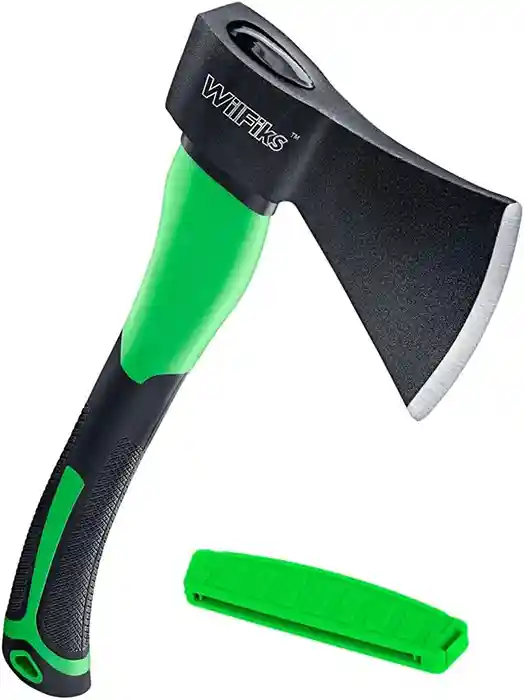
Features:
- Sturdiness
- Maneuverability
- Ergonomic design
- Durability & easy to use
- Durable construction
- Ergonomic design
- Resharpenable blade
- Easy to store
Technical Information:
- Brand: WilFiks
- Handle Material: Fiberglass, Steel, Wood
- Size: 15″ Inch Camping Axe
- Head Type: Hatchet
- Item Dimensions: 1 x 1 x 1 inches
3. ESTWING Fireside Friend Axe – 14 inch, E3-FF4

Features:
- Comfortable, durability & sturdiness
- Value for money
- Solid America Steel
- Hand Sharpened Edge
- Shock Reduction Grip
- Nylon Sheath Included
- Specifically designed for splitting
- Made In The USA
Technical Information:
- Brand: Estwing
- Item Dimensions: 14.25 x 5.83 x 1.5 inches
- Handle Material: Leather, Nylon, Steel, Wood
- Color: Blue
- Head Type: Splitting Maul
4. INTERTOOL 15-inch Hatchet, 1.8 lb / 800 g, HT-0262
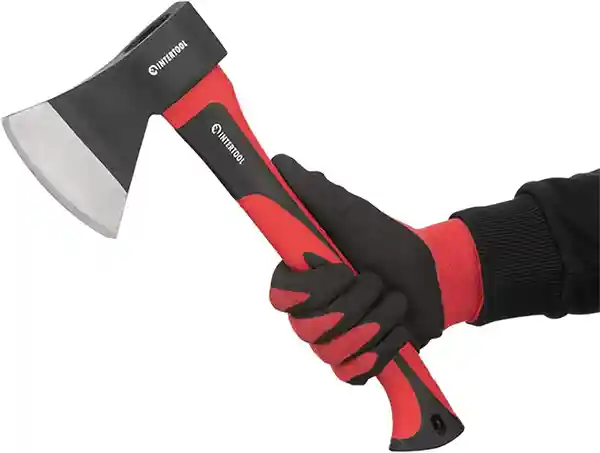
Features:
- Carbon Steel: High-quality steel with anti-corrosion coating.
- Sharpened Blade: Heat treated and polished to maintain a sharper edge.
- Shock Absorbing: Dampens vibrations to help absorb heavy impact.
- Fiberglass Handle: Lightweight and durable with anti-slip rubberized coating.
- Hang Hole: For hanging and safe storage.
Technical Information:
- Brand: INTERTOOL
- Handle Material: Fiberglass
- Color: Red, Black
- Head Type: Hatchet
- Item Dimensions: 15.2 x 1 x 6.3 inches
5. KURUI Wood Chopping Axe with Sheath, 15-inch

Features:
- Sturdiness
- Weight distribution
- Ergonomic design
- Easy wood splitting
- Comfortable handle
- Sharpened blade for easier wood chipping
- Ideal axe for camping and wood splitting
Technical Information:
- Brand: KURUI
- Handle Material: Fiberglass
- Color: Yellow
- Head Type: Hatchet
- Style: Hatchet
6. ARES 45002 – 9-Inch Camping Hatchet
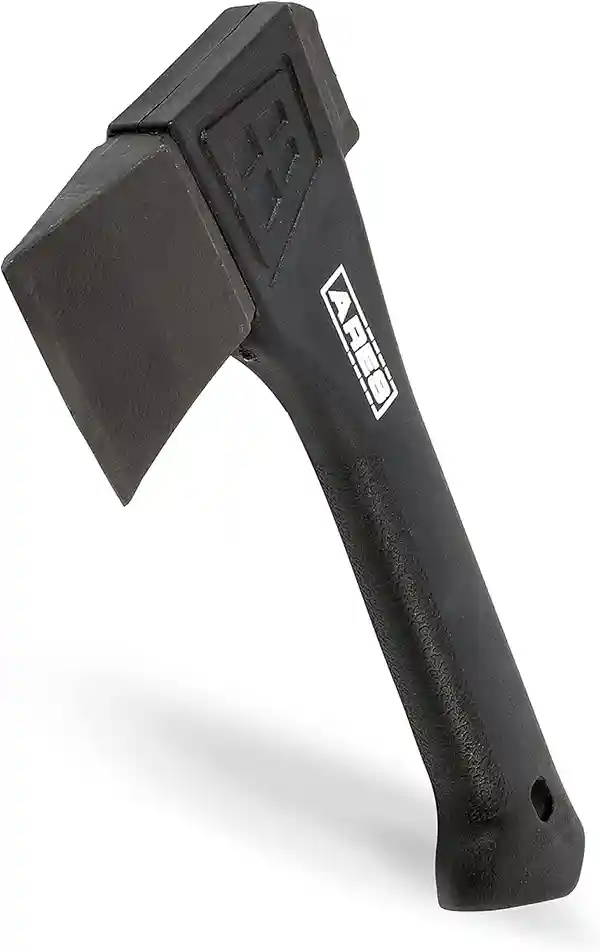
Features:
- Fiberglass over-molded construction.
- Perfect weight distribution.
- Increasing swing speed and striking power.
- Reliable, effective, and efficient.
- Lightweight and sturdy, making it easy to carry and swing.
- Providing increased durability and strength for any outdoor activity.
- The head is constructed of drop-forged and heat-treated grade A high-carbon steel.
Technical Information:
- Brand: ARES
- Item Dimensions: 11 x 6.1 x 1.42 inches
- Handle Material: Fiberglass, Steel
- Color: Black
- Head Type: Hatchet
7. INTERTOOL 15-inch Wood Splitting Axe, HT-0274

Features:
- Carbon Steel: High-quality steel with anti-corrosion coating.
- Sharpened Blade: Heat-treated and polished to maintain a sharper edge.
- Shock Absorbing: Dampens vibrations to help absorb heavy impact.
- Fiberglass Handle: Lightweight and durable with anti-slip rubberized coating.
- Hang Hole: For hanging and safe storage.
Technical Information:
- Brand: INTERTOOL
- Handle Material: Fiberglass
- Color: Red
- Head Type: Splitting Maul
- Item Dimensions: 15 x 2 x 5.5 inches
8. ESTWING Camper’s Axe – 14 inch, EB-25A
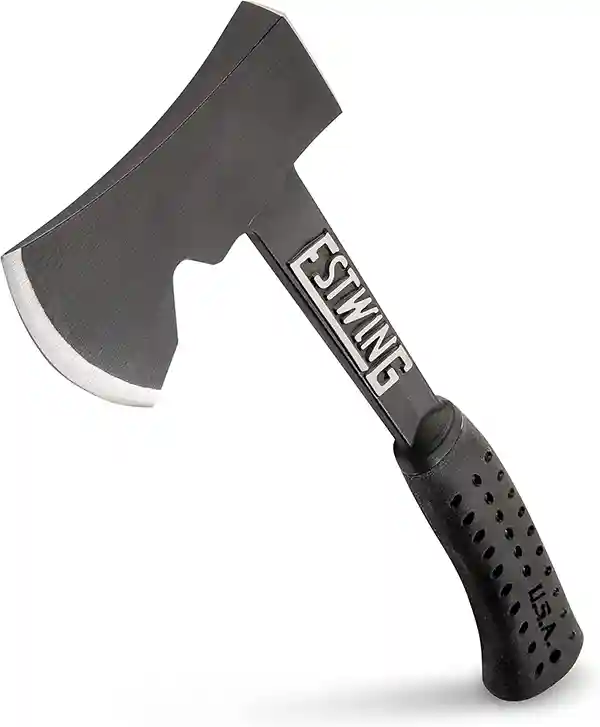
Features:
- Ergonomic design
- Durability & sturdiness
- Forged using the finest tool-grade steel
- Hand-sharpened and polished
- Forged using the finest tool-grade steel
- Heavy-duty sheath
- Forged perfection
- Drop forged and tempered
- Patented perfection
- Unique design
- Proudly Made in the USA
Technical Information:
- Manufacturer: Estwing
- Item Weight: 2 pounds
- Country of Origin: USA
- Size: 14-inch
- Color: Black
- Style: Hatchet
- Material: Steel
- Power Source: Hand Powered
- Product Dimensions: 4.5 x 1.25 x 14.25 inches
9. 1844 Helko Werk Germany Traditional Black Forest Woodworker Axe, Head 2.25 lbs, Handle 24-inch

Features:
- Handmade in Germany
- C50 High carbon steel
- Grade A American hickory handle
- Gull grain leather sheath
- Comfort & lightweight
- Ergonomic design
- Dimensions: Head Weight: 2-1/4 lb, Length: 24 in, Total Weight: 3-1/2 lb
Technical Information:
- Brand: 1844 Helko Werk Germany
- Handle Material: Steel, Wood
- Color: Black
- Item Weight: 3.75 Pounds
- Item Dimensions: 24 x 7 x 1.5 inches
10. BRUFER 203651-3 Hatchet Axe with Genuine Hickory Wood Handle 600g 21oz
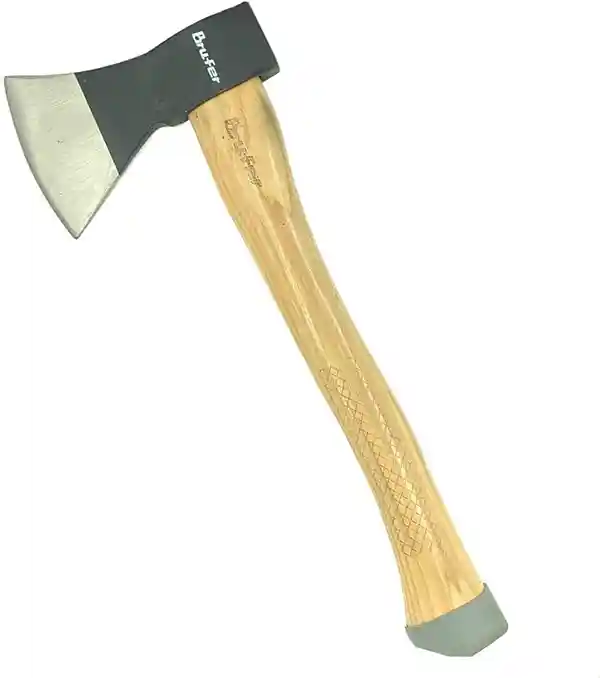
Features:
- Lightweight & durability
- Ergonomic design
- Drop-forged carbon steel head
- Genuine hickory wood handle
- Head weight: 600 grams or 21 ounces
- The total length is 14-1/2″ with a blade length of 4″
Technical Information:
- Brand: BRUFER Quality Products
- Item Dimensions: 14.5 x 6 x 1 inches
- Handle Material: Hickory, Steel, Wood
- Color: Natural
- Head Type: Hatchet
Different types of blades on gardening axes
There are several types of blades on garden axes, each designed for specific tasks. The common types of blades on garden axes are:
- Single-bevel blade: A single-bevel blade is angled on one side only. It is ideal for cutting in one direction and is typically used for chopping wood.
- Double-bevel blade: A double-bevel blade is angled on both sides. It allows for cutting in both directions and is ideal for pruning and shaping.
- Curved blade: A curved blade is ideal for precision cutting and is typically used for tasks such as pruning and shaping.
- Straight blade: A straight blade is ideal for chopping wood and is typically used for tasks such as splitting logs.
- Wedged blade: A wedged blade is used for chopping wood and is shaped like a wedge to split wood easily.
- Chisel blade: A chisel blade is typically used for digging and chopping roots. It is a straight, pointed blade with a sharp edge.
- Swiss Pattern: These blades are common in small hand-held axes or hatchets. They are designed for precision cutting and have a curved edge that is designed for pruning, shaping, and carving.
The choice of the blade will depend on the specific task you need to perform. A hatchet or garden axe with a single-bevel blade or a wedged blade is good for chopping wood, while a double-bevel blade or a curved blade is good for pruning and shaping.
A straight blade or a chisel blade is good for digging and chopping roots.
Various types of handles on a gardening axe
There are several types of handles on garden axes, each with its own unique features and characteristics.
- Wooden Handle: Wooden handles are the most traditional and most common type of handle on garden axes. They are usually made of hardwood such as hickory or ash and are relatively inexpensive. They are durable and comfortable to hold but can absorb moisture and can crack or split over time.
- Fiberglass Handle: Fiberglass handles are a more modern and durable alternative to wooden handles. They are made of a combination of fiberglass and resin, which makes them resistant to moisture and impact. They are also lightweight and have a good grip. However, they can be more expensive than wooden handles.
- Composite Handle: Composite handles are made of a combination of materials, such as plastic and rubber, that make them lightweight, durable, and resistant to moisture. They are similar to fiberglass handles but generally more affordable.
- Steel Handle: Steel handles are more durable than wooden or composite handles, and they offer a good grip. They are also rust-resistant and easy to clean, but they can be heavy and can conduct heat or cold.
Ultimately, the choice of the handle will depend on personal preference, budget, and the intended use of the axe. Wooden handles are traditional and comfortable but can absorb moisture, fiberglass, and composite handles are durable and resistant to moisture, and steel handles are durable and easy to clean but can be heavy.
Types of headings on gardening axes
The heading of an axe refers to the shape and design of the metal part of the axe, which is the part that is used for cutting. The different types of headings on garden axes are:
- Single Bit: Single bit is the most common type of axe head. It has one cutting edge that is sharpened and used for chopping wood or cutting branches.
- Double Bit: A double-bit axe has two cutting edges, one on each side of the head. This allows for cutting in both directions and is ideal for pruning and shaping.
- Wedged: A wedged heading is designed with a wedge-shaped edge that makes it easy to split wood.
- Chisel: A chisel heading is designed with a straight, pointed blade with a sharp edge that makes it good for chopping and digging roots.
- Felling: Using felling heading is cutting down trees. It has a sharp edge that’s usually thicker than others, making it suitable for cutting bigger branches and trunks.
- Splitting: This type of splitting heading is designed for splitting wood. It’s usually bigger and heavier than other types of heads, and the edge is also thicker and more robust, making it easier to split wood.
Each type of heading has its own advantages and disadvantages and the choice of heading will depend on the specific task you need to perform. A single-bit heading is good for chopping wood.
A double-bit heading is good for pruning and shaping. Wedged and splitting heading is for splitting wood. A chisel heading is for digging and chopping roots, felling heading is for cutting down trees.
Gardening axes available on the market
There are several different types of gardening axes available on the market. Such as Felling Axe, Splitting Axe, Maul, Hand Axe, Hatchet, Pruning Axe, and Japanese Garden Hatchet.
These are the most common types of gardening axes available on the market. There are also other variations such as axes with different materials for the handle (such as rubber or aluminum) and different shapes or designs for the head. Some brands also offer axes with interchangeable heads for different tasks.
How to choose the best gardening axes?
Choosing the best gardening axe will depend on your specific needs and the tasks you need to perform. Here are some factors to consider when selecting a gardening axe:
- Size: Consider the size of the axe head and the length of the handle. A smaller axe head and shorter handle are good for precision cutting and shaping, while a larger axe head and longer handle are good for chopping wood and cutting down trees.
- Blade: A single-bevel blade is good for chopping wood, while a double-bevel blade is good for pruning and shaping.
- Handle: Wooden handles are traditional and comfortable, while fiberglass and composite handles are durable and resistant to moisture.
- Heading: A single bit is good for chopping wood, while a double bit is good for pruning and shaping. Wedged and splitting heading for splitting wood, chisel heading for digging and chopping roots, felling heading for cutting down trees.
- Weight: Consider the weight of the axe. A lightweight axe is easy to maneuver and use for precision cutting, while a heavier axe is better for chopping wood and cutting down trees.
- Safety: Choose an axe that has proper safety features, such as a non-slip grip, a good balance, and a sheath to protect the blade when not in use.
It’s also important to consider the overall quality of the axe, including the materials used in its construction and the craftsmanship of the manufacturer. A well-made axe will last longer, be more durable and perform better than a poorly made one.
Conclusion
Several types of gardening axes serve a variety of tasks. Such as pruning, shaping, chopping, splitting, and cutting wood.
A smaller axe head and shorter handle are good for precision cutting and shaping, while a larger axe head and longer handle are good for chopping wood and cutting down trees.
The single-bevel blade is good for chopping wood, while the double-bevel blade is good for pruning and shaping. Wooden handles are traditional and comfortable, while fiberglass and composite handles are durable and resistant to moisture.
It’s also important to consider the overall quality of the axe, including the materials used in its construction and the craftsmanship of the manufacturer.
Remember that, always use safety equipment and appropriate techniques when using any kind of axe.



